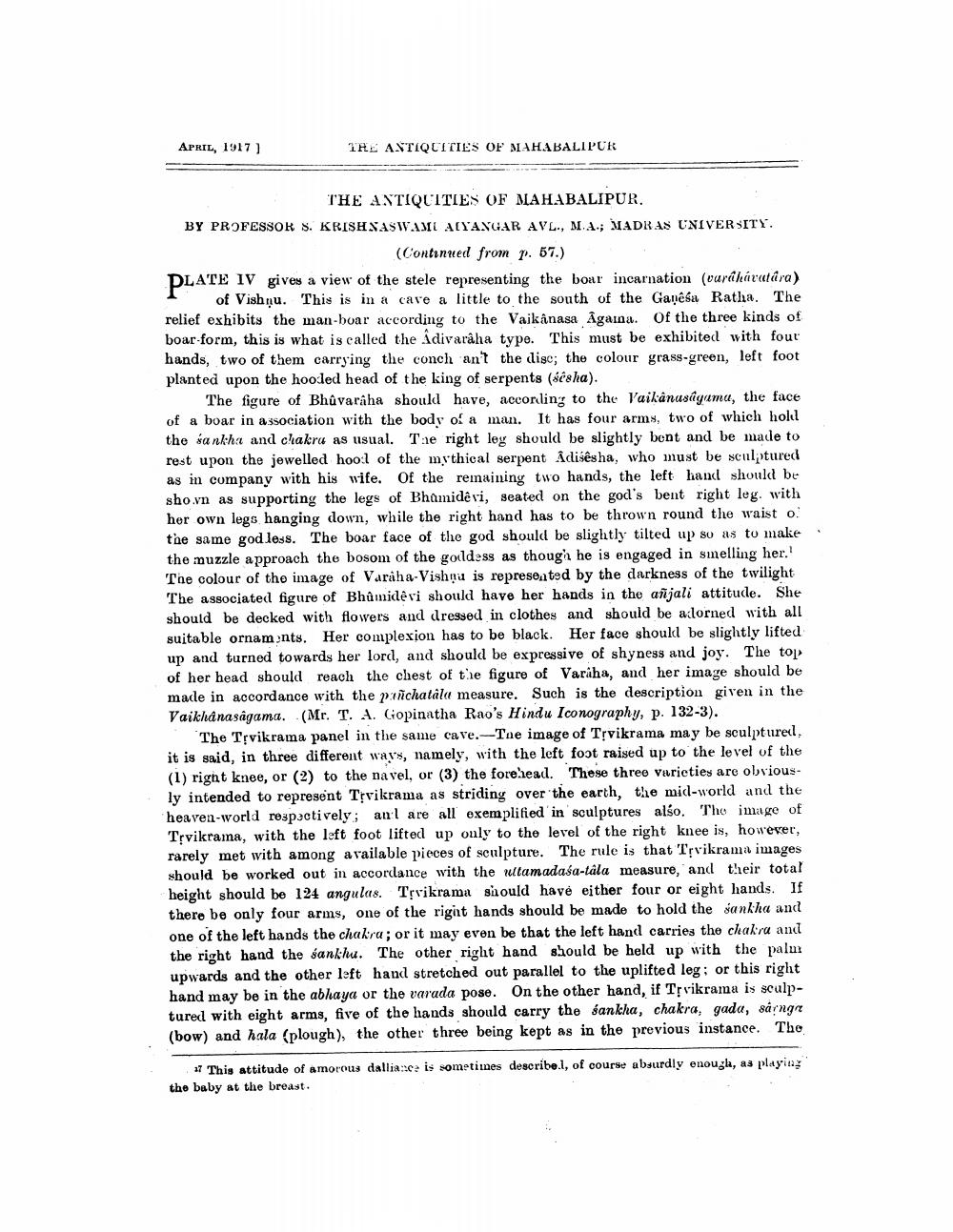________________
APRIL, 1917)
TR ANTIQCITIES OF MAHABALIPCR
THE ANTIQUITIES OF MAHABALIPUR. BY PROFESSOR S. KRISHSASWAMIL AYANGAR AVL, MA; MADRAS UNIVERSITY
(Continued from p. 57.) DLATE IV gives a view of the stele representing the bour incarnation (vurahavatara)
of Vishņu. This is in a cave a little to the south of the Ganesa Ratha. The relief exhibits the man-boar according to the Vaikanasa Againa. Of the three kinds of boar-form, this is what is called the Adivarâha type. This must be exhibited with four hands, two of them carrying the conch an't the disc; the colour grass-green, left foot planted upon the hooled head of the king of serpents (sesha).
The figure of Bhůvaraha should have, accorling to the Vaikanasayamu, the face of a boar in association with the body of a man. It has four arms, two of which holil the sankha and chakru as usual. Tie right ley should be slightly bent and be madle to rest upon the jewelled hool of the mythical serpent Adišêsha, who must be sculptured as in company with his wife. Of the remaining two hands, the left hand should be sho.vn as supporting the legs of Bhamideri, seated on the god's bent right leg, with her own legs hanging down, while the right hand has to be thrown round the waist o: the same god less. The boar face of the god should be slightly tilted up so as to make the muzzle approach the bosom of the goldess as though he is engaged in smelling her.! The colour of the image of Varaha-Vishnu is represented by the darkness of the twilight The associated figure of Bhumidevi should have her hands in the añjali attitude. She should be decked with flowers and dressed in clothes and should be aclorned with all suitable ornam nts. Her complexion has to be black. Her face should be slightly lifted up and turned towards her lord, and should be expressive of shyness and joy. The top of her head should reach the chest of the figure of Variha, and her image should be made in accordance with the prichatâla measure. Such is the description given in the Vaikhanasagama. (Mr. T... Gopinatha Rao's Hindu Iconography, p. 132-3).
The Tţvikrama panel in the same cave.-Tne image of Trvikrama may be sculptured it is said, in three different ways, namely, with the left foot raised up to the level of the (1) right knee, or (2) to the navel, or (3) the forehead. These three varieties are obviously intended to represent Tyvikrama as striding over the earth, the mid-world and the heaven-world respectively; anl are all exemplified'in sculptures also. The image of Trvikrama, with the left foot lifted up only to the level of the right knee is, however, rarely met with among available pieces of sculpture. The rule is that Tpvikrama images should be worked out in accordance with the ullamadasa-tala measure, and their total height should be 124 angulas. Trvikrama should have either four or eight hands. If there be only four arms, one of the rigit hands should be made to hold the sankha and one of the left hands the chakra; or it may even be that the left hand carries the chakra and the right hand the sankhu. The other right hand should be held up with the palm upwards and the other left hand stretched out parallel to the uplifted leg: or this right hand may be in the abhaya or the varada pose. On the other hand, if Trvikrama is sculptured with eight arms, five of the hands should carry the sankha, chakra, gada, sårngr (bow) and hala (plough), the other three being kept as in the previous instance. The
17 This attitude of amorous dalliae is sometimes describe.l, of course absurdly enouzla, as playing the baby at the breast.




